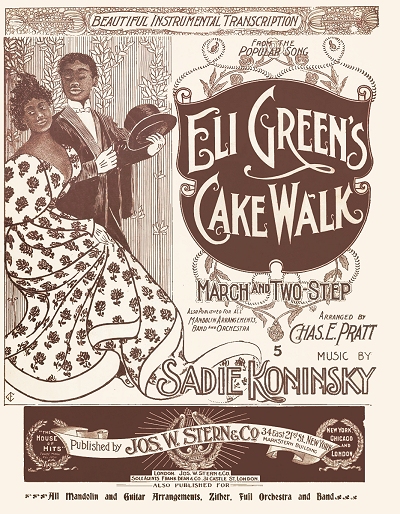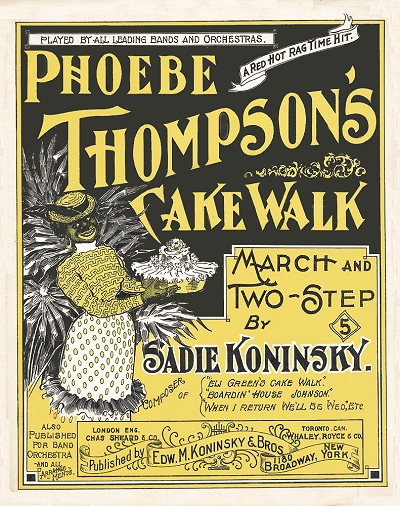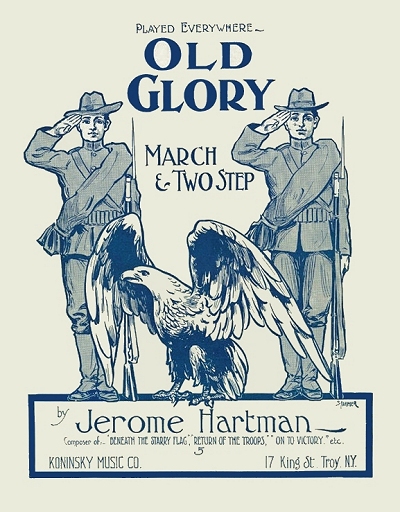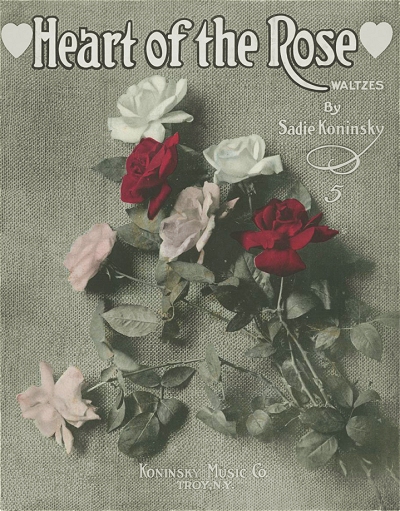Sadie Koninsky left a fairly impressive legacy in composition, and not just in ragtime. She spent the bulk of her life in Troy, New York, born there as Sarah Koninsky to German/Polish father Harris Koninsky and British mother Mary Goodman. She was the youngest of five children, including Edward M. (1/1865), Esther (1866) David Harris (9/1869), and Maurice (Moses) Nathan (7/23/1874). Esther died in the 1870s. In the 1870 census, and in ads going back to the late 1860s in Troy, Harris was shown runing a second-hand clothing and bedding store. For the 1880 enumeration, he was listed as a tailor and Edward, shown as 16, was a clerk. Sadie was listed under her probable birth name of Sarah, a common given name from which Sadie could be derived. Her listed birth years fluctuated wildly over the next decades, but the 1920 census falls in line with an 1877 year of birth. In an 1890 Troy city directory the family was residing at 404 River. Harris was shown then as working in the furniture business, Edward was still listed as a clerk, as was David, and Maurice was listed as a musician.
Sadie's first known published composition was issued by the house of M. Witmark in 1894. The Belles of Andalusia was a pleasant Spanish-tinged waltz. This was followed in 1895 by a typical march of the era, The Minstrel King, published in Albany. However, she first came to prominence at the age of 19 or 20. While training to become a classical violinist, a skill for which she turned out to be very capable, Miss Koninsky then wrote Eli Green's Cake Walk. It was quickly picked up by Joseph W. Stern for publication, and Stern had lyrics added by staff writer Dave Reed to further benefit from the demand for cakewalk songs.
However, she first came to prominence at the age of 19 or 20. While training to become a classical violinist, a skill for which she turned out to be very capable, Miss Koninsky then wrote Eli Green's Cake Walk. It was quickly picked up by Joseph W. Stern for publication, and Stern had lyrics added by staff writer Dave Reed to further benefit from the demand for cakewalk songs.
 However, she first came to prominence at the age of 19 or 20. While training to become a classical violinist, a skill for which she turned out to be very capable, Miss Koninsky then wrote Eli Green's Cake Walk. It was quickly picked up by Joseph W. Stern for publication, and Stern had lyrics added by staff writer Dave Reed to further benefit from the demand for cakewalk songs.
However, she first came to prominence at the age of 19 or 20. While training to become a classical violinist, a skill for which she turned out to be very capable, Miss Koninsky then wrote Eli Green's Cake Walk. It was quickly picked up by Joseph W. Stern for publication, and Stern had lyrics added by staff writer Dave Reed to further benefit from the demand for cakewalk songs.At a time shortly after cakewalk dance music had been introduced into publication, Sadie, a Jewish white woman, was able to successfully capture the feeling of the typical black-composed cakewalk. Furthermore, it was published under her real name, a feat not often duplicated for this genre until a few years later when women such as Charlotte Blake and May Aufderheide started putting out ragtime works. The success of the tune convinced her to seek instruction to gain some further pianistic skills with Harriet Brower, a respected teacher and author of The Mastery of the Piano, This was likely to help with her ability to construct good piano scores, but Sadie ultimately kept the violin as her instrument of choice, training under Kate Atherton Barker, head of the Violin Department of the Emma Willard Conservatory in Troy. Upon completion of her education, Koninsky took on students of her own in Troy, as well as working as a soloist with various ensembles in the area. Her success with Eli Green's Cake Walk allowed her to secure a job as a staff arranger for a short time with the Stern publishing house.
In the 1898 Troy city directory, the Koninsky family was shown as still living at 404 River, with Harris heading H. Koninsky & Sons, a pawnbroker firm that included David and Edward. Sadie listed music as her occupation. She was in business with Maurice,  running what appears to be M. N. & S. Koninsky, dealers of music. By 1899 their local firm, now a full-fledged music publisher, was known as Edw. M. Koninsky & Brothers. In a 1957 article, Edward was referred to as the businessman of the family. One of their first publications was a female follow up to Eli Green, Phoebe Thompson's Cakewalk. In 1900 they opened an office at 1130 Broadway in Manhattan to secure better visibility in the industry. They also snatched promoter Harry S. Marion from the firm of Frederick Mills and had him run the Broadway office.
running what appears to be M. N. & S. Koninsky, dealers of music. By 1899 their local firm, now a full-fledged music publisher, was known as Edw. M. Koninsky & Brothers. In a 1957 article, Edward was referred to as the businessman of the family. One of their first publications was a female follow up to Eli Green, Phoebe Thompson's Cakewalk. In 1900 they opened an office at 1130 Broadway in Manhattan to secure better visibility in the industry. They also snatched promoter Harry S. Marion from the firm of Frederick Mills and had him run the Broadway office.
 running what appears to be M. N. & S. Koninsky, dealers of music. By 1899 their local firm, now a full-fledged music publisher, was known as Edw. M. Koninsky & Brothers. In a 1957 article, Edward was referred to as the businessman of the family. One of their first publications was a female follow up to Eli Green, Phoebe Thompson's Cakewalk. In 1900 they opened an office at 1130 Broadway in Manhattan to secure better visibility in the industry. They also snatched promoter Harry S. Marion from the firm of Frederick Mills and had him run the Broadway office.
running what appears to be M. N. & S. Koninsky, dealers of music. By 1899 their local firm, now a full-fledged music publisher, was known as Edw. M. Koninsky & Brothers. In a 1957 article, Edward was referred to as the businessman of the family. One of their first publications was a female follow up to Eli Green, Phoebe Thompson's Cakewalk. In 1900 they opened an office at 1130 Broadway in Manhattan to secure better visibility in the industry. They also snatched promoter Harry S. Marion from the firm of Frederick Mills and had him run the Broadway office.Sadie had become a very adequate song writer by the time of this expansion. The Music Trade Review of June 23, 1900, gave her credit where it was due in terms of her role with the company:
The Review heard a number of songs from their catalogue this week, and they are of a very fine order. Miss Sadie Koninsky is the genius of the firm, and it is she, who is entitled to credit for the songs. "When I Return We'll Be Wed," "You Alone," "I Didn't Think You Cared To Have Me Back," "Sing Me a Song of Other Days," are four songs of the sentimental style, in which the lyrics and melody are both by Sadie Koninsky. "I Wants a Man Who Ain't Afraid To Work," is a coon song also by this talented composer, and shows her great versatility. All these songs are being sung by various top-liners, in different parts of the country, and the orders for them come steadily along.
Their catalog was bolstered by the inclusion of pieces by the somewhat well-known composer Arthur Trevelyan. The Manhattan branch of Koninsky Brothers was open only from mid-1900 to 1901.
For the 1900 enumeration Sadie listed her profession as musician as did Maurice. She and her older brothers, Edward, David and Maurice, also formed their own ensemble around 1904, and were listed as the Koninsky Orchestra for more than 20 years, based in Troy. Neither Sadie, Maurice or David ever married, but Edward did leave Troy for Rochester, New York, and was wed, producing one child from the union. With all of her brothers, Sadie expanded the sheet music enterprise, changing the name to the Koninsky Music Company. They conducted their retail business from Frear's Department Store in Troy. The firm published out of the former Troy Times newspaper building, but their listed address was 17 King Street where the family now lived.
Sadie took on multiple roles as the primary composer, arranger, and song plugger for Koninsky Music. Most of her marches were released under the name Jerome Hartman (perhaps women simply were not supposed to write good marches). It has been thought in the past that she also composed under the name of Julius K. Johnson, as he was responsible for the company's biggest hit in 1910, King of the Air and three other lesser marches. However, since compositions of Johnson's have been found published by other houses in the Midwest, the author is certain that the Johnson in question was likely the prominent L.A. organist of the 1920s and 1930s born in St. Paul, Minnesota. One other potential name discovered during research was Kathryn Bayley, who wrote only reveries, and only for Koninsky Publishing.
It has been thought in the past that she also composed under the name of Julius K. Johnson, as he was responsible for the company's biggest hit in 1910, King of the Air and three other lesser marches. However, since compositions of Johnson's have been found published by other houses in the Midwest, the author is certain that the Johnson in question was likely the prominent L.A. organist of the 1920s and 1930s born in St. Paul, Minnesota. One other potential name discovered during research was Kathryn Bayley, who wrote only reveries, and only for Koninsky Publishing.
 It has been thought in the past that she also composed under the name of Julius K. Johnson, as he was responsible for the company's biggest hit in 1910, King of the Air and three other lesser marches. However, since compositions of Johnson's have been found published by other houses in the Midwest, the author is certain that the Johnson in question was likely the prominent L.A. organist of the 1920s and 1930s born in St. Paul, Minnesota. One other potential name discovered during research was Kathryn Bayley, who wrote only reveries, and only for Koninsky Publishing.
It has been thought in the past that she also composed under the name of Julius K. Johnson, as he was responsible for the company's biggest hit in 1910, King of the Air and three other lesser marches. However, since compositions of Johnson's have been found published by other houses in the Midwest, the author is certain that the Johnson in question was likely the prominent L.A. organist of the 1920s and 1930s born in St. Paul, Minnesota. One other potential name discovered during research was Kathryn Bayley, who wrote only reveries, and only for Koninsky Publishing.In Troy musical society, Sadie was known as one of the finest violinists around, and taught in that trade for some years, but also played piano from time to time. The pianist of the family was clearly Maurice, as he was known as a go-to accompanist anytime there was a need for a visiting artist. At age 11, he and a friend, who eventually became a producer, staged the recent Gilbert and Sullivan musical comedy, The Mikado, in Troy. Maurice was also a composer, although the work he did with Sadie was mostly as a lyricist. David worked for many years as a musician, specializing in cornet, playing with local bands and orchestras.
For the 1910 census Sadie is shown living with her now widowed mother Mary and her brothers David and Maurice (known by this time in Troy as Moe). David was the proprietor of their music store, and Maurice and Sadie listed themselves as publishers of songs. As of 1918, the draft record for Maurice showed him still residing with his mother, and his occupation listed as the musical director for Proctor's Theater, one of a chain of vaudeville theaters. He was also known as having worked at the Griswold Theater. As remembered by William Noller, leader of the Troy City Band, "Moe had fingers like wings on the piano. He was one of the best. He knew harmony and he would play the newly-issued numbers in the music department at Frear's where he always attracted a crowd." In 1918 Maurice and Sadie wrote and staged their own Japanese-American operetta, The Belle of Tokio, which appears to have been confined to only Troy. It had encores in 1919 and 1921.
He knew harmony and he would play the newly-issued numbers in the music department at Frear's where he always attracted a crowd." In 1918 Maurice and Sadie wrote and staged their own Japanese-American operetta, The Belle of Tokio, which appears to have been confined to only Troy. It had encores in 1919 and 1921.
 He knew harmony and he would play the newly-issued numbers in the music department at Frear's where he always attracted a crowd." In 1918 Maurice and Sadie wrote and staged their own Japanese-American operetta, The Belle of Tokio, which appears to have been confined to only Troy. It had encores in 1919 and 1921.
He knew harmony and he would play the newly-issued numbers in the music department at Frear's where he always attracted a crowd." In 1918 Maurice and Sadie wrote and staged their own Japanese-American operetta, The Belle of Tokio, which appears to have been confined to only Troy. It had encores in 1919 and 1921.The 1920 enumeration showed Sadie as 42, again challenging her birth year. Mary was still heading the household, with David, Maurice and Sadie listed as music publishers. In the 1920s Sadie started a separate publishing house in Troy, Goodwyn Music Publishers. She also took up teaching the violin and music both privately and in Troy area schools. David was a vocal teacher at the LaSalle Institute for many years during this period. The Koninsky Music Company finally closed in the mid-1920s. By the time of the 1930 census Mary had died. Sadie was shown as still living at 17 King Street with David and Maurice, and all three were listed as musicians, likely playing for dance bands or orchestras, and teaching as well.
A 1932 Troy directory listed Maurice as a piano and vocal teacher, and Sadie as a violinist. David showed no occupation, likely having retired by this time. Moe was the best known musician of the family, playing piano not only in local bands but also as part of a trio on station WHAZ at Rensselaer Polytechnic Institute for a number of years, and pianist for the Maurice String Ensemble on station WTRY. Moe could also be heard playing at times in Schenectady on WGY He also was long regarded as a good substitute concert accompanist in a pinch, once directing a show with 300 cues while sight reading it all. Sadie and her brothers moved to 120 Second Street in the late 1930s, where she would live for over a decade. The three siblings were found there in the 1940 census, all listed as music teachers.
David died in 1942 and Maurice in May 1944, just four days after his last performance at the local Jewish Community Center. Sadie kept plugging away at her musical passion. In the 1947 Troy directory, she was still listed as a violin teacher approaching age 70. The 1950 census showed no occupation, but she claimed her age to be only 60. Sadie Koninsky outlived her older siblings, dying at 74 years of age on the second day of 1952, following a long illness. She was interred at the B'rith Sholom Cemetery in Troy.
Sadie's obituary listed her as a composer of more than 300 numbers, but many may have gone unpublished or are just lost to history. Her considerable net estate from royalties and other holdings was $50,613 was distributed in part among several local Jewish organizations, and largely to her niece, Edward's daughter, Marjorie K. Brainan of Rochester. It is unknown if this included any of the physical assets of the publishing company. However, it did include her fine violin, of which she asked Marjorie to "give the violin to a talented needy Jewish student, preferably a child, of the Eastman School of Music in Rochester." What finer final tribute could there be for such a great musical legacy.
Thanks as always to Ragtime Women historian Nora Hulse, for information on some of Koninsky's activities in Troy. The bulk of the information was researched by the author from public records, embedded sheet music information, periodicals and newspapers.
 Compositions
Compositions